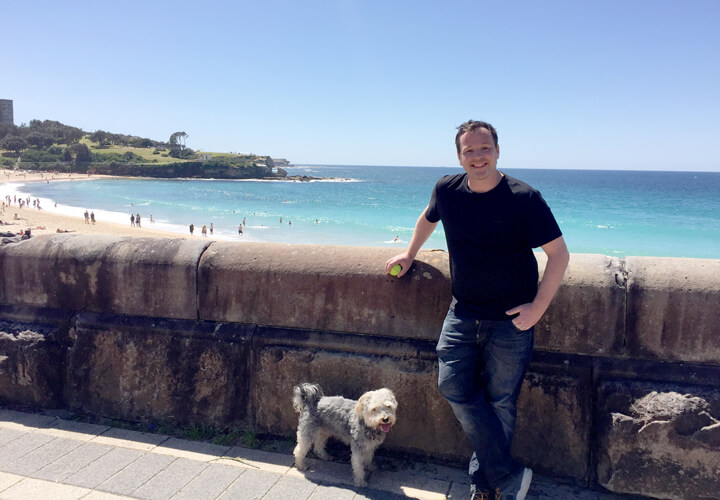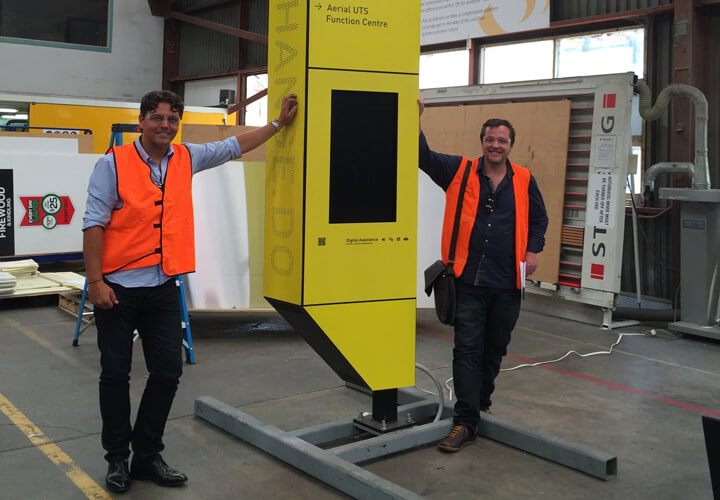Nick Bannikoff is one of the most experienced wayfinding designers in Australia, but he didn’t always want to be an experiential graphic designer.
He studied architecture, followed by industrial design, and then travelled around the world for a few years – all before finding his true calling. As Design Manager at BrandCulture, Nick is involved in some of Sydney’s most complex infrastructure projects. His ideas are changing the way people experience our city, from Circular Quay to Sydney Train’s suburban network.
Lots of people probably don’t know what wayfinding design is. So … what is it?
The biggest mistake I often come across is the thought that wayfinding is just ‘signs’. Wayfinding encompasses an entire environment and all of the information required for a visitor to successfully understand, rather than just navigate, a space. Sight, sound, touch and smell can all be wayfinding cues in the right context. To do it right, it’s a real collaboration.
Is wayfinding an art or a science?
I think all design is part art, part science. The process we go through isn’t: “Let’s stick a sign here and a logo here”. We analyse the space, understand what needs to be communicated and how people make decisions. We’re also interested in the science of how things are made, and the science of how things interact. But at the end of the day creating something both beautiful and meaningful is what creates passion for both the designer and audience.
Why were you drawn to environmental and wayfinding design?
I kind of fell into it. Wayfinding and experiential graphics were not widely recognised as specialties in the late ’90s, when I answered a job advertisement without a lot of understanding of the industry.
What I quickly found was that the particular requirements of the field – an understanding of both the macro (architectural) and micro (finite details and industrial design) – perfectly reflected my design interests.
Is there something about thinking about how people move around, make decisions or get lost that appeals to you?
I do love solving a really difficult wayfinding problem. I used to do cryptic crosswords and I think there are similarities. Wayfinding projects have all these disparate issues going on that require lateral thinking. I get a kick out of changing a site that’s really difficult to navigate, especially where there is something new attached to something old. I also like the challenge of building something meaningful and long-term. When I see our designs in context, I do feel really proud.
What’s changed since you first started out as a designer?
A lot of companies and government departments recognise the benefits of working with a wayfinding specialist or a studio with an in-depth understanding of brand.
Efficiency is one reason people have realised wayfinding is so important. BrandCulture recently completed a wayfinding project for Atlassian. Our strategy was built around a massive influx of new staff joining the company every week. If you save everybody in that company 15 minutes a week by making it easier for them to find their way around, it can equate to millions of dollars worth of improved productivity.
Do you have any advice for anyone considering a career in environmental design & wayfinding?
My advice is applicable to any aspiring designer. The key to good design is to understand your client, not just what they have briefed you on, but the underlying connections, themes and assumptions that are driving a project. What do they hope to achieve? What are their constraints? What opportunities exist? Who is their audience? Most importantly, what haven’t you been briefed on? If you can address the unasked questions you can create truly meaningful design solutions.
What does a typical day look like for you?
Looooooong. ☺ It’s both structured and free flowing. After a WIP, I’ll spend time with team members either briefing in or providing guidance on anything from graphic design, how to manufacture or specify something, or the best structure for a presentation. There might be a proposal to write, project and company planning, and of course rolling my sleeves up to actually do some design and documentation. Plus client meetings to take briefs, present concepts or coordinate a project. If I’m very lucky I’ll get to go on a site visit.
Do you have a creative outlet outside of work?
I love to cook. I started many years ago with Mediterranean cuisine, moved on to Middle Eastern and over the last five years or so have started to explore eastern and south east Asian food. I love creating something that you can’t find at a restaurant and experimenting with new ingredients and techniques. Also, like all designers I’m always doing a small job or two for select family and friends.




